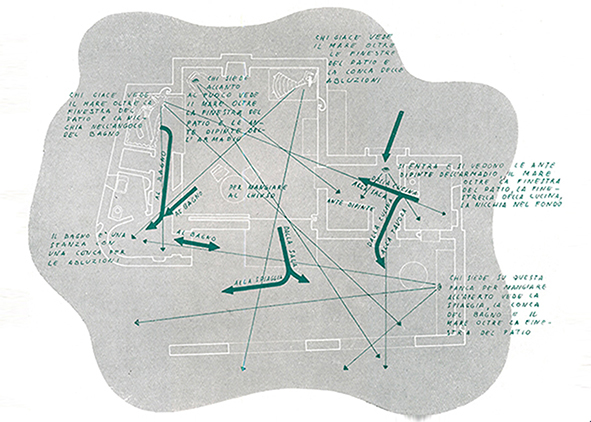Houses in the Wood to enjoy the Sun and the Stars
DOI:
https://doi.org/10.19229/2464-9309/2212017Keywords:
medmediterranean architecture, house, hotel in the woodAbstract
In 1938, Gio Ponti and Bernard Rudofsky worked out a project for a hotel in the woods in which architecture and landscape should blend into one in an endless toeing and froing whereby the indoor spills into the outdoor and the landscape breaks into the house. Based on Ponti’s original drawings, the author goes through the space of one of the hotel rooms by building a physical model of it. The photographs of the hotel, taken from the perspectives mentioned by the author and the angle argued from the general layout, are a way to understand the relationships between man, architecture and landscape, as suggested by the drawings and descriptions of the project.
Downloads
Article Metrics Graph
References
Bocco Guarneri, A. (2003), Bernard Rudofsky – A human designer, Springer Verlag, Wien-NewYork.
Guarnati, D. and Ponti, G., (1954), Aria d’Italia. Espressione di Gio Ponti (1954), n. 8, Daria Guarnati Editore, Milano.
Irace, F. (1986), “A proposito dell’arredo domestico – Gio Ponti e la casa attrezzata”, in Ottagono, n. 82, pp. 50-59.
Irace, F. (1988), “Le ville al mare”, in Gio Ponti – La casa all’italiana, Electa, Milano, pp. 139-150.
Licitra Ponti, L. (2004), “Gio Ponti et la fabrique du regard”, in L’architecture d’aujourd’hui, n. 351, pp. 62-69.
Licitra Ponti, L. (1990), Gio Ponti - L’opera, Leonardo, Milano.
Miodini, L. (2001), Gio Ponti – Gli anni trenta, Electa, Milano.
Platzer, M. (2007), Lessons from Bernard Rudofsky – Life is a voyage, Birkhauser, Basel.
Ponti, G. (1957), Amate l’architettura – L’architettura è un cristallo, CUSL, Milano, p. 110.
Ponti, G. (1941), “Come la casa al mare? Come le case sulle coste della Dalmazia?”, in Stile, n. 8, p. 23.
Ponti, G. (1941), “Facciamoci una coscienza nazionale della architettura mediterranea”, in Stile, n. 7.
Ponti, G. (1941), “Un nuovo tipo d’albergo progettato da Ponti e Rudofsky per le coste e le isole del Tirreno e che può essere ideale per la Dalmazia”, in Stile, n. 8, pp. 16-22.
Ponti, G. (1940), “Albergo di San Michele o nel bosco all’isola di Capri”, in Architettura, fascicolo VI, pp. 273-286.
Ponti, G. (1940), “Colore nei pavimenti”, in Corriere della Sera, 9 ottobre 1940.
Ponti, G. (1939), “Una casa al mare”, in Domus, n. 138, pp. 34-39.
Ponti, G. (1939), “Una piccola casa ideale”, in Domus, n. 138, p. 44.
Ponti, G. (1937), in Domus, n. 115.
Rostagni, C. (2011), Gio Ponti e il Corriere della Sera, 1930-1963, Rizzoli, Milano, pp. 292-296.
Rossi, U. (2016), Bernard Rudofsky architetto, Clean, Napoli.
Rossi, U. (2010), “Questo albergo è una casa – Gio Ponti, Bernard Rudofsky: albergo di San Michele a Capri, 1938”, in Mantese, E. (ed.), Abitare con – Ricercario per un’idea collettiva dell’abitare, Canova edizioni, Treviso.
Rudofsky, B. (1952), “Giardino, stanza all’aperto – A proposito della Casa giardino a Long Island NY”, in Domus, n. 272, pp. 3-4.
Rudofsky, B. (1938), “Non ci vuole un nuovo modo di costruire ci vuole un nuovo modo di vivere”, in Domus, n. 123, pp. 6-15.

Downloads
Published
How to Cite
Issue
Section
License
This Journal is published under Creative Commons Attribution Licence 4.0 (CC-BY).
License scheme | Legal code
This License allows anyone to:
Share: copy and redistribute the material in any medium or format.
Adapt: remix, transform, and build upon the material for any purpose, even commercially.
Under the following terms
Attribution: Users must give appropriate credit, provide a link to the license, and indicate if changes were made; users may do so in any reasonable manner, but not in any way that suggests the licensor endorses them or their use.
No additional restrictions: Users may not apply legal terms or technological measures that legally restrict others from doing anything the license permits.
Notices
Users do not have to comply with the license for elements of the material in the public domain or where your use is permitted by an applicable exception or limitation.
No warranties are given. The license may not give users all of the permissions necessary for their intended use. For example, other rights such as publicity, privacy, or moral rights may limit how you use the material.


















































































